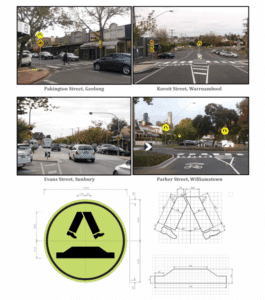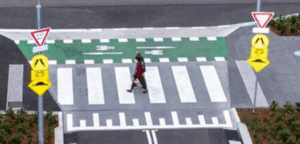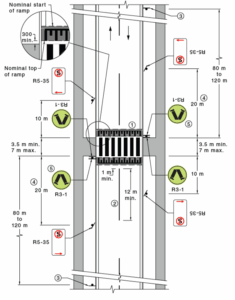Raised pedestrian crossings (or wombat crossings as they’re commonly known in Australia) are among the best treatments we have for improving pedestrian safety and accessibility. They reduce vehicle speeds, enhance pedestrian visibility, and make crossing the road safer and more accessible for everyone, including those with prams, mobility aids or visual impairments.
Back in 2019, our frustration with the sheer number of signs required for a wombat crossing, and the inconsistent application, reached a tipping point. We wrote an article with examples (and even sketched up our own concept sign):

It struck a chord it seems. It turns out we weren’t the only ones annoyed by the sign clutter. And it looks like the Australian Standards Committee for Traffic Control Devices was listening. The recently updated AS 1742.10 reflects a welcome change.
What was in the old Standard?
The previous version of AS 1742.10 often required a combination of the following signs at a raised crossing:
- Pedestrian crossing sign (R3-1)
- Road hump warning sign (W5-10)
- Supplementary speed advisory sign (W8-2)
- Advance pedestrian crossing warning sign (W6-2)
- Advance hump warning sign (W3-4)
That’s a lot for a driver to process – especially in a short space of time. It also contributes to broader issues of sign clutter.
And sign clutter isn’t just untidy. It can compromise safety by making it harder for drivers to detect and process the most critical information. When there are too many signs, people start tuning out and important warnings get lost in the visual noise.

What’s changed?
In the latest edition of AS 1742.10, all that’s required at the crossing itself is the pedestrian crossing sign (R3-1). A massive simplification.

But what about warning drivers of the hump?
A common question we’re asked is:
“Under the new Standard, can I still use a hump warning sign at a raised crossing?”
Yes – but only if it’s needed, and only in advance of the crossing in combination with the advance pedestrian crossing warning sign (W6-2). It’s also a new thin looking hump supplementary plate (W8-31)
W6-2-1 in combination with the new W8-31
Where would you use this set-up? Only where visibility of the Pedestrian Crossing (R3-1) sign is obstructed due to road alignment or other location specific conditions.
The goal is clear
We should only sign what is necessary, and we should do it in a way that:
- Supports driver comprehension and expectation
- Prioritises the safety function of the treatment
- Avoids undermining its effectiveness through visual overload
Why raised crossings work
There’s strong and growing evidence that raised crossings reduce crashes, lower crash severity, and improve driver yielding. They also deliver major accessibility benefits by providing an at-grade path across the road, without the need to step off kerbs or navigate uneven surfaces.
By combining vertical deflection with pedestrian priority, raised crossings encourage safer driver behaviour and more respectful sharing of space.
Less is more
Like all safety treatments, raised crossings need to be tailored to context. It’s not just about the infrastructure – it’s about how we communicate its purpose through signs and markings.
Using only the signage that’s necessary, and removing what’s redundant or confusing, helps declutter the streetscape and makes roads safer for everyone. And when extra warning is needed? The new W8-31 and its trusted companion W6-2 are there to help.

Follow Safe System Solutions Pty Ltd for Safe System Snippets, industry news and events, technical training course schedules and more.

